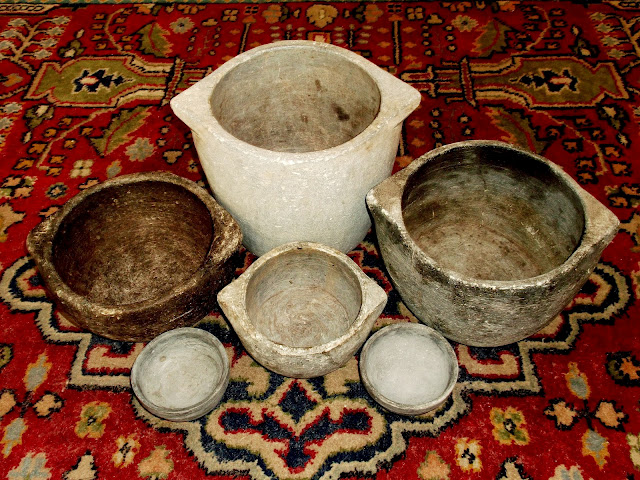 |
| Stone Cooking Pots Arranged in a Group |
These beautiful stone cooking pots will be the pride of any kitchen and are antique collectors’ delight. They are hand-carved out of a single block of soft stone, known as soapstone. These soap stone pots are mostly used in southern states of India like Andhra Pradesh, Tamil Nadu, Kerala and Karnataka. They are called Ratichippa in Telugu language (rati-stone, chippa- cooking pot) and “Kalchatti” in Tamil language (kal-stone, chatti-cooking pot).
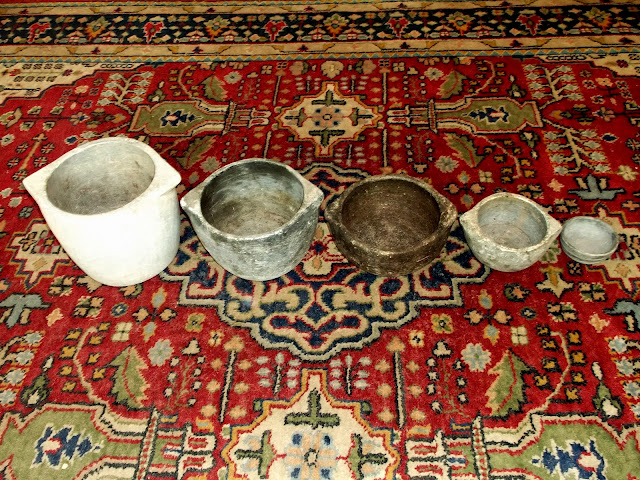 |
| Stone Cooking Pots Arranged According to Size |
I have grown up with Ratichippa culture. My mother used to prepare in the stone pot shown in this picture (picture-3) food items like Mukkala Pulusu (vegetables cooked in tamarind juice with seasoning) and majjiga pulusu (a preparation with butter milk with or without vegetables) and pappu pulusu (lentils cooked in tamarind juice). My wife continues the tradition and every Sunday we have a special meal with traditional Andhra dishes and the Mukkala pulusu is invariably cooked in the same Ratichippa. Whenever we get important visitors to our home or in family gatherings during festivals, we prepare the traditional dishes in this stone pot and bring the same pot to the dining table for serving. This stone pot has been present in our family since three generations and we treat this pot as one of our family members with great care, love and attachment.
Stone cooking pot from YK’s family
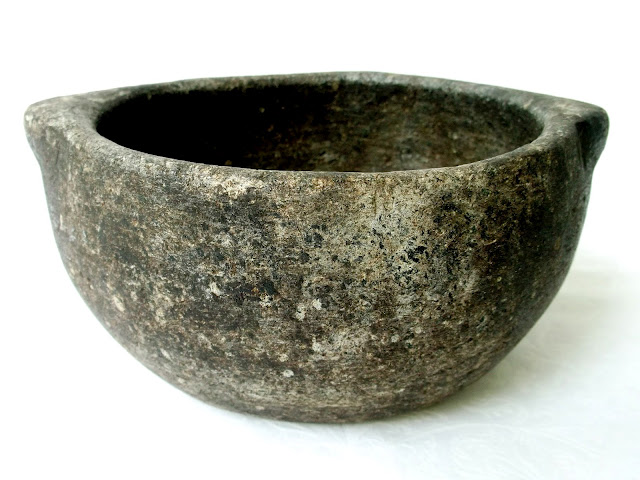 |
| Stone Cooking Pot (Rathi-Chippa) from YK’s Family Collection |
My wife Ramana always tells me that her paternal grandmother used to cook daily all items of food like curries, pulusus, sambar, rasam etc in Ratichippa only with the exception of rice for which she used to use a separate brass vessel and they used to taste heavenly. The secret why the food cooked in the stone pots taste so heavenly is that they are chemically inert and hence do not alter or change the natural flavors of the ingredients and retain the original aroma and taste of the food. Also in stone pots the food is cooked uniformly and evenly.
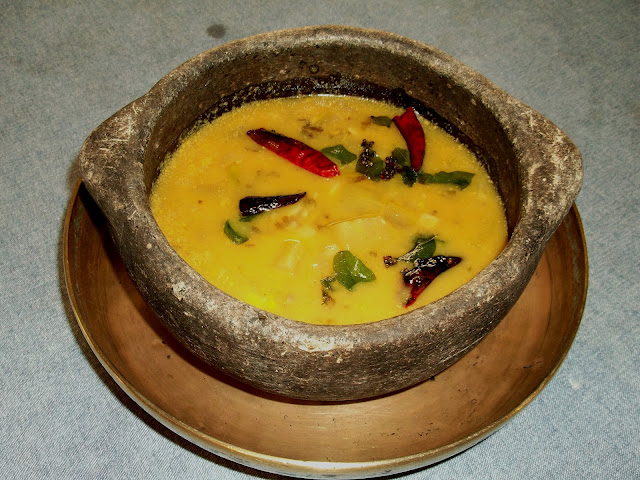 |
| Stone cooking Pot (Rathi-Chippa) from YK’s family Collection With Mukkala Pulusu |
This Ratichippa gets naturally darkened with seasoning and aging due to continuous use. My mother used to apply a paste made out of ashes or fine clay soil around the lower part of the Ratichippa before putting it on the fire. She used to do entire cooking using firewood for fire and subsequently shifted to charcoal. This is to prevent smoke settling on the stone surface and to make the cleaning easy. With washing of ash or clay the smoke settled on the surface also goes away thus protecting the stone surface from the pressure of rubbing and scrubbing. This is how the stone pot has been preserved for three generations.This pot is 9 cm high and 17 cm in diameter at the mouth opening.
Stone cooking pot from Mr.Ramanathan
The second pot (shown in the picture-4) is larger in size, measuring 18 cm in height and 19 cm in diameter. It has light gray colour since it is not used much. Soap stones are in light gray colour when they are new and they acquire darker shade, almost black, with age and seasoning.
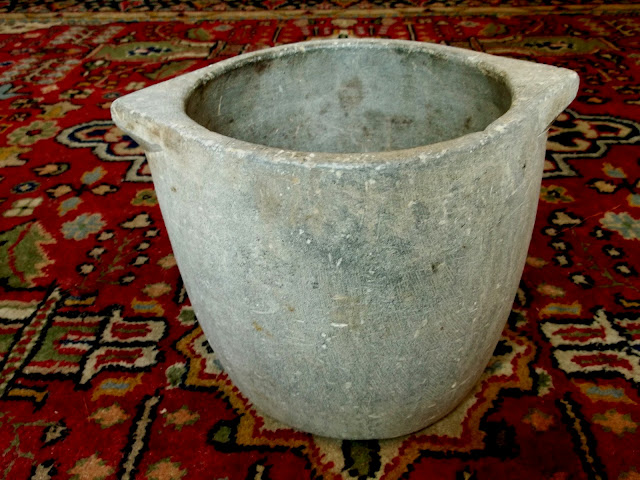 |
| Stone Cooking Pot (Kalachatti) from Mr.Ramanathan |
There is an interesting story as to how I acquired this marvelous stone pot. I was shifted to Mumbai by my company in the year 1989 and they gave me a company-leased flat belonging to one Mr. Ramanathan. Mr.Ramanathan shifted to his own new flat. When we inspected our flat, it was clean but on the loft there was this stone pot sitting alone. Immediately we rang up Ramanathan and informed him about the stone pot which they call kalchetti in their language Tamil. He told us they did not want to take this old kalchetti to their new house since they wanted only glittering new items there and told us that the kalchetti can be there in the loft.
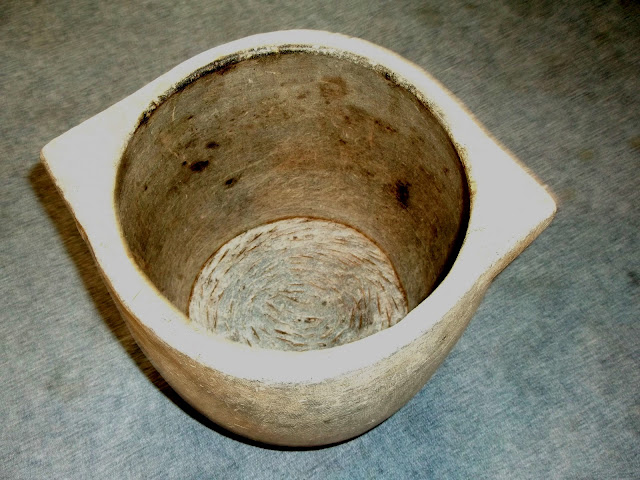 |
| Stone Cooking Pot (Kalchatti) from Mr. Ramanathan – Top View |
After three years of stay in that flat we shifted to another flat and again rang up Ramanathan and told him to take care of his stone vessel. He told us that they were not interested in the old item and if we wished we can take it. This was a pleasant surprise for me and I grabbed this cute beauty. Subsequently I asked him as to how he got the stone pot, he told me that his mother-in-law was very fond of stone pot cooking and she purchased this piece from Tanjavur city, a great cultural centre in Tamil Nadu state. I think this pot was not used ever since they purchased it. We have also not used this pot since we want to keep a sample of an unused pot. This must be around 35 years old but unused.
Stone cooking pot gifted by mr.Prasad
The third pot (shown in picture-5) measures 13 cm in height and 18 cm in diameter. It is dark in color indicating it has been used for a long time and is quite old. Even the wall of this stone pot is thin indicating that it took a lot of rubbing by way of cleaning. Here again we have an interesting story as to how we got this wonderful stone cooking pot.
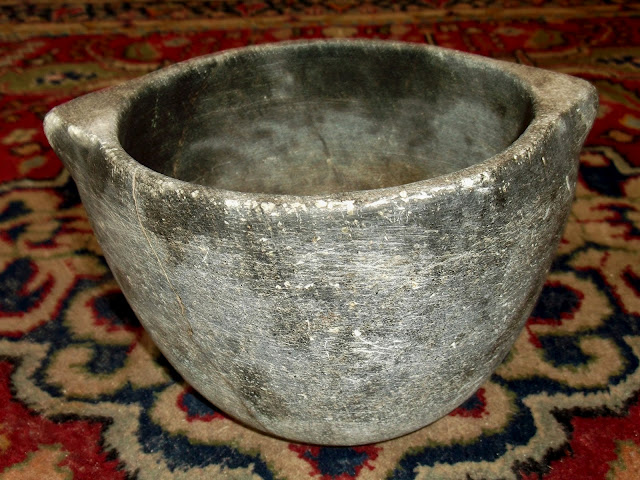 |
| Stone Cooking Pot Gifted by Mr. Prasad |
My wife Ramana does social service for needy people. She did some help for one couple, the husband’s name is Prasad and his wife’s name is Ratnam. They used to come to our house whenever they needed some service and watch our antique collection. One day they saw our stone cooking pot collection and they told us they also have two pieces of old stone pots. Since they were not using, they kept them in the attic (loft) with other junk and soon they will locate them for us. One fine morning, Mr. Prasad came home with these two beauties and declared that they should be added to our collection as a gift from him. On enquiry, they told us they did not purchase these items, but they were given to them by their parents and have been present in their family for three generations. This must be around 60 to 70 years old.
Stone cooking pot gifted by mr.Prasad
The 4th pot ( shown in picture-6) measures 7 cm. in height and 13 cm. in diameter. The story here is same as the story of pot 3 since they came from the same source and at the same time.
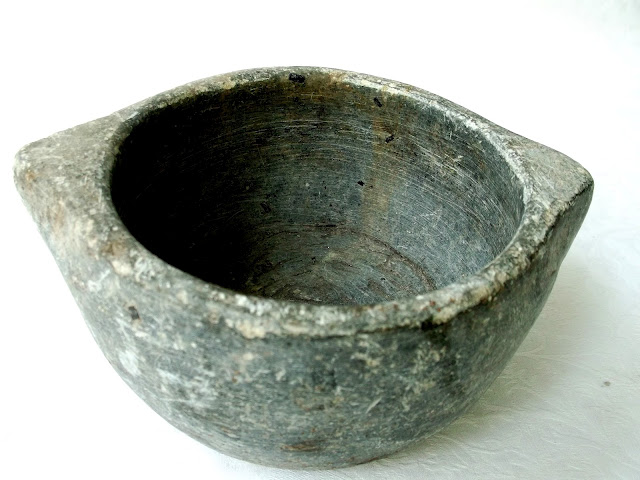 |
| Stone Cooking Pot Gifted by Mr. Prasad |
This pot is smaller in size but from the appearance we can make out that it is used very extensively.
Stone cooking pot from Puri This pot (shown in picture 9) measures 4.d cm. in height and 9 cm. in diameter. This is a relatively new stone pot which we acquired near Lord Jagannath temple during our trip to Puri, a temple town in the state of Odisha, India.
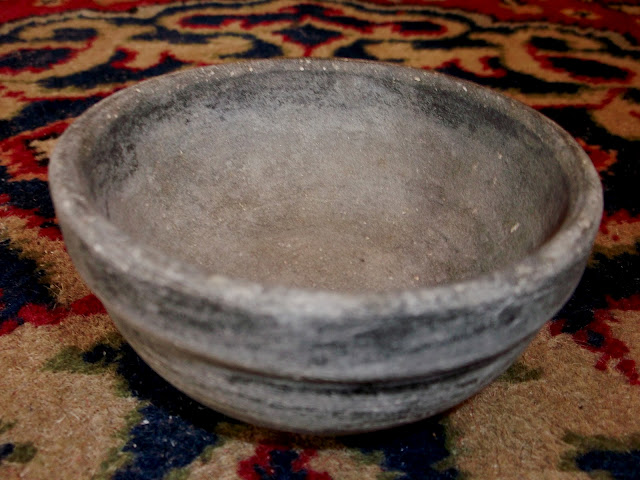 |
| Stone Cooking Pot from Puri (Jagannath Temple) |
This small pot is ideally suited to serve pickles or chutneys on the table. It is an age-old wisdom that any food item preserved in the stone pot will not perish even for months. The stone pots of larger size are used for storing pickles to serve for one year for the entire family and they remain fresh throughout the year.
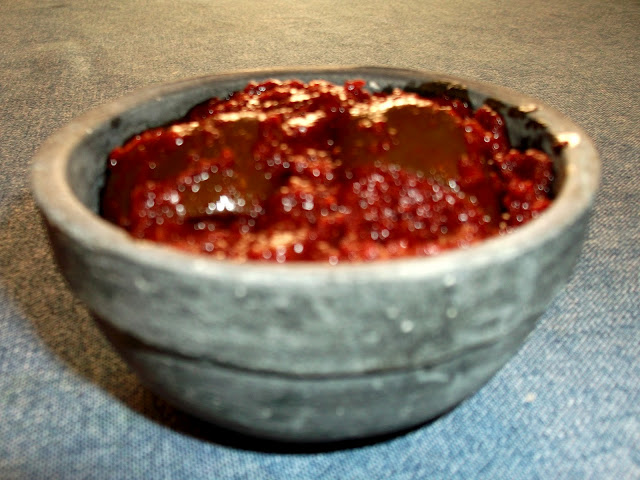 |
| Stone Cooking Pot from Puri (Jagannath Temple) – With Mango Prickle |
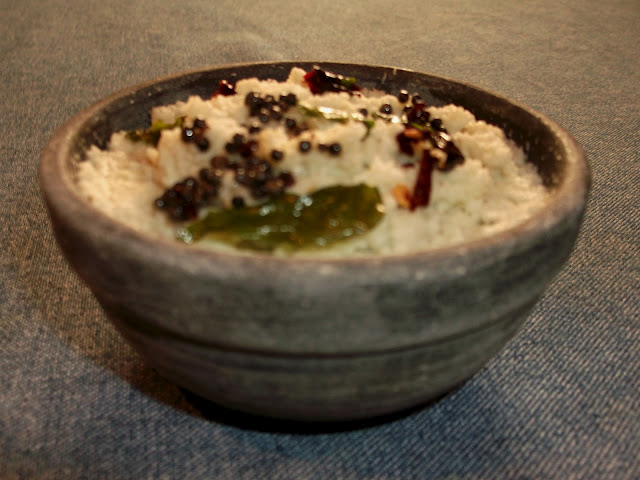 |
| Stone Cooking Pot from Puri (Jagannath Temple) – With Coconut Chutney |
Seasoning of the stone cooking pots
The soap stone cooking pots are soft, fragile and porous. They have to be seasoned before you put them on fire for cooking. If you put them on fire without seasoning they may break or crack. For seasoning keep the salt water in it for a few hours and then wash the entire pot with the same water. Subsequently pour and store to the full some starchy water like the water you get after washing the rice or the starchy water you get when you drain the excess water after the rice is cooked. This starchy water is called Kanji. Subsequently wash the entire pot with the same starchy water.
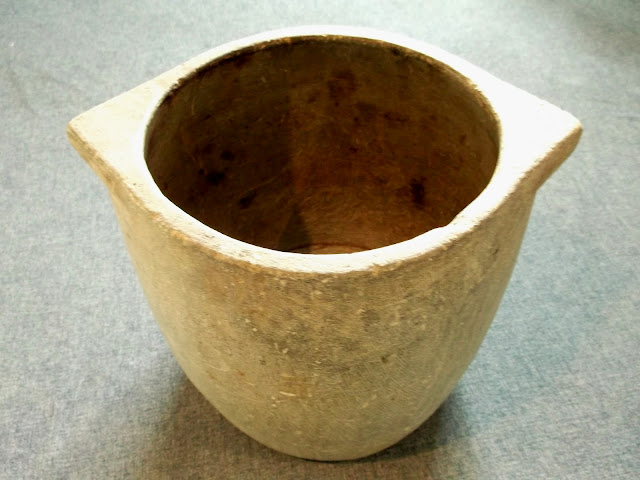 |
| New Stone Cooking Pot to be Seasoned |
Repeat this process for six or seven days. Now the new stone pot is ready to be kept on the fire for cooking purpose. Once the pot is seasoned and the pores of the stone get sealed and the surface gets less absorbent and denser. Also the colour of the stone pot turns darker.
How to handle stone pot:
By nature the soap stone pots are gentle and fragile and hence have to be handled with care. Do not handle them by the rim of the pot. Always hold them with both hands and have a grip with the fingers around the body of the pot.
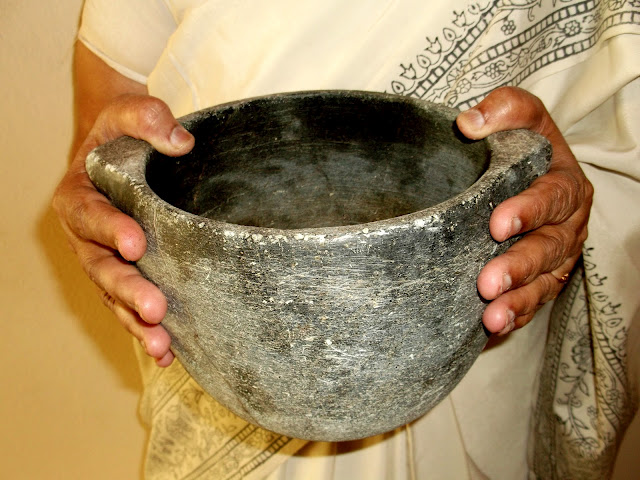 |
| Picture Showing how to Carry Stone Cooking Pot |
The pot will be hot for many hours after cooking. If you want to take the hot pot to the dining table, place the pot on a strong plate (preferably wood or brass) and carry by holding the plate. Keep the pot along with the plate on the dining table for serving purpose.
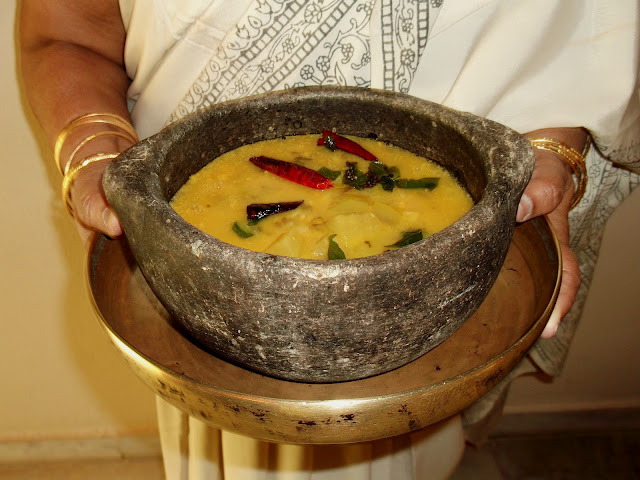 |
| Picture Showing how to Carry Hot Stone Cooking pot |
Important points on stone pot cooking
Soap stone take a longer time to get heated and in the same way it also takes longer to get cooler. Since the stone retains the heat you should know that the food will continue to get cooked even after you remove the pot from the heat source. There is a chance of the food getting over-cooked. So, you should properly manage the cooking time and stop the heat source in time giving allowance for the off-the-fire cooking time.
Soap stone pots serve the purpose of cooking the food as a serving dish. The food will be hot on the table for a long time. Stone vessels can withstand temperatures up to 1,000 F and can be safely used also for oven cooking.
Do not keep an empty stone vessel on the fire. Always keep something in the pot and then only keep it on the fire. There is always a chance of their breaking if you expose them to dry heat.
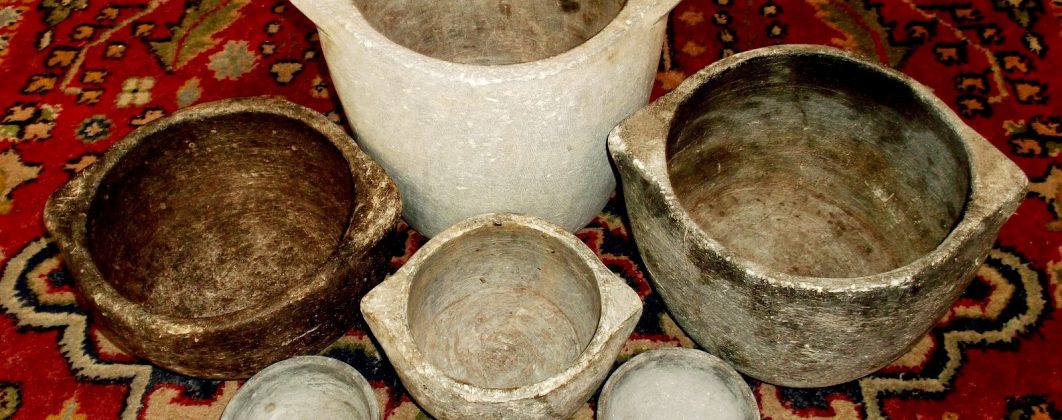















30 Responses
Mamayyagaru Nice informative blog. will be waiting for the next post. Vani
Vani.good to know you liked the blog.This is my humble attempt to preserve and spread our cultural heritage.YK
Can i keep the pot on stove with little oil for tadka .. because for few recipes we need start with tadka..
Hello. Thank you for writing to us. It is not advisable to use the stone cooking pot for tadka. The stone cooking pot has to go on to the fire with at least 1/4th of any liquid already in it, preferably half.
We should understand that stone is not like metal. Stone is porous and in the minute pores, moisture or air or both are present.
When the stone pot is heated, the moisture or air trapped in the pores expand. If the temperature reaches the entire stone cooking pot evenly, then the pores will also expand uniformly and the stone cooking pot is intact.
If only partial heat is there on the surface and the rest of the pot is at room temperature, the heated part would only expand and the non-heated area remains as it is. This imbalance in the temperature on the surface of the pot creates cracks.
In your case, the tadka temperature will be mostly at the bottom and the rest of the area will be at normal temperature. It may result in cracks. Hope this information helps.
hi , I recently seasoned a new stone pot for 3-4 days with starch water and started cooking on the gas stove on medium heat..but kalchatti cracked on the stove..can you pls let me know how I can confirm the seasoning is sufficient to start using the POT..appreciate your help in this regard.
Thanks
Kundhavai
hi iam looking for a rathi chippa pot for myself and i found your blog online and found it very informative,could you help me find one in hyderabad or chennai maybe?
Hi I am so glad to know there are people who really use these vessels. I am fascinated and want to buy them
Good to remember child hood memories.when I was young , my mother used to make different types of pulusulu in that rathichippas, they used to be very tasty. When thry are broken, we used them as chalk to write on the floor, and used to enjoy that also , this is very good blog
I live in Hyderabad was trying to buy these rathi chippa for a very long time. I really remember my amma cooking in these vessels. I would love to buy with your guidance.
Hello Sir. Thank you for responding. My mother used to make
So nice to know that there are blogs on “kalchatti”. I recently bought one from kumbakonam and the vessel is called “makal chetti” and was googling to know how to season it .. that’s when I came across your blog. Will follow the procedure mentioned here to season my kalchatti and hope it won’t crack
Makal is a soft rock stone and can write with it on cemented floor. I got it from a store in kumbeshwarar sannadhi street in kumbakonam. The name of the shop is new Saravana stores and Sri Saravana traders. Prop: K. Balakrishnan, ph no. 9894723380, 8925580166. Hope this helps
My kalchetti looks the same as yours. The stone which is used to make the vessel is called makal in Tamil. And I believe that all the stone vessel is made of makal only
Sir, you have said that kalchetti should not be put empty on fire and that we should put required water in it. Can we put oil in it before keeping it on fire???
Thanks for the nice explanation sir…
Sir, today after seasoning my kalchetti for almost 14 days with starch and salt water, I kept it on fire with 3/4 of my kalchetti filled with water. I must admit that I was scared and was praying that it should not break as if it does than I my efforts of seasoning it all these days it go waste. And luckily it did not. So, can I consider that my kalchetti passed the test and it is ready to cook some delicious dishes for us…??
Hello Sir memu telugu vallame, glad to see your great collection,my great grand mother used to make charu in Rachippa,you remind me those days thank you sir.
Where can I buy these pots. Would also love to buy a small tiragali. Am going to raja under in July. Please can some one give me info. Thanks
Sorry going to rajahmundry and Kakinada
Lovely pots on display
Dear sir
I am so thankful to your blog . Thanks to you i could find my long time search of kal chattis
Mr Balakrishnan – sri saravana stores was more tahn willing to help me out to get the products of desire
I thank the person who has posted the number
Thank you Riya Rajesh
Where do we get these rathichippas in hydarabad
Where do we get these rathicippas in hydrabad and visakhapatnam
Hello YK garu, its such a wonderful collection and very happy to found this site.I always liked these antiques from childhood.My grand father had these rati chippa’s of violet and beige color of different shapes.My mom just thought them as of normal stones and left them.
Where do we get rathichippas in banglore
Where do i get rathichippas in banglore
Thankuverymuch for that information
Hi,I found interesting about stone cookware.I live in south Delhi,could u pl.tell me from where Ivan get these cookware?
I hve a stone pot with a Lid more like a caserrole pot
is this unusual?
It was purchased in Iran 50 years ago.
hi i also wants to start some type of this antiques pots in poona and online will u help me